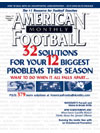AMERICAN FOOTBALL MONTHLY THE #1 RESOURCE FOR FOOTBALL COACHES
Article CategoriesAFM Magazine
|
The Sprint Out Pass GameDispelling the myth of implementing a sprint out package in your offenseby: Mike Kuchar Senior Writer, American Football Monthly © More from this issue With every offensive coach these days designing their scheme to find ways to get the ball to the perimeter, it seems like the sprint out pass game would be a viable option. But the truth is, many teams donít utilize this package in their offense, mainly due to the fact that they may not have a QB mobile enough to do it or they donít have the time to devote to a totally separate package. But what if we were to dispel those two myths directly in this article? Itís true. In fact, many of the coaches we spoke with agree that you truly donít need a Pat White (although it most certainly helps) to run the scheme. And, if youíre worrying about overloading your offensive playbook, you can rid yourself of that thought as well. Many sprint out packages are designed with the same type of combination routes that are used in the three-and....The full article can only be seen by subscribers. Subscribe today!
|
|
|||||||
| HOME |
MAGAZINE |
SUBSCRIBE | ONLINE COLUMNISTS | COACHING VIDEOS |
Copyright 2025, AmericanFootballMonthly.com
All Rights Reserved





